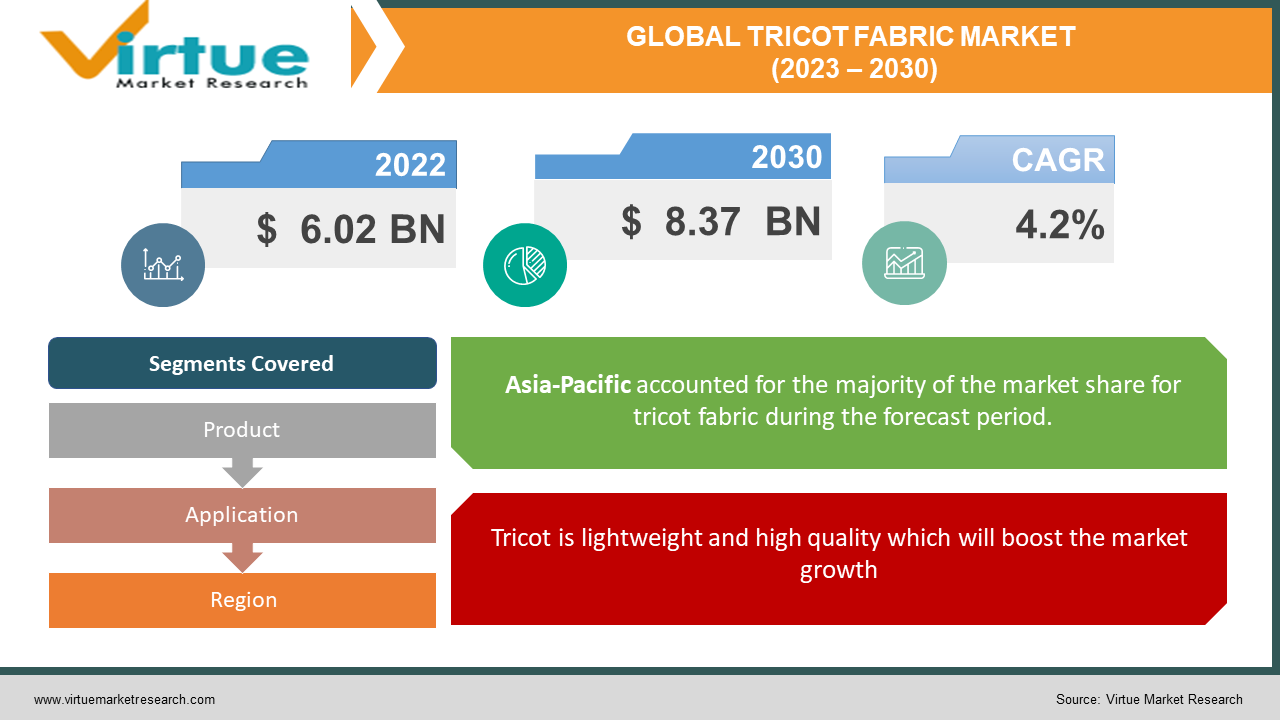Global Tricot Fabric Market Size (2023 – 2030)
The global tricot fabric market size was at USD 6.02 billion in 2022 and is estimated to reach a total market valuation of USD 8.37 billion by 2030. The market is projected to grow with a CAGR of 4.2% per annum during the period of analysis (2023 - 2030).
Industry Overview
The need for light raw materials including polypropylene, linen, silk, faux fur, and synthetic fibres is being fueled by a shift in consumer taste for lightweight, high-performance knitwear. Bulky yarns used to make knitted fabrics have been replaced by woven fabrics. The demand for cardigans, shawls, scarves, and jackets with loop stitches has been steadily increasing over the past few years in the apparel business. Grey, traditional black, brown, and beige have become more popular colour choices around the world.
Additionally, due to the material's improved breathability, demand for feather-light circular knit materials has grown in the hosiery industry. The market for protective gear has seen tremendous growth in lightweight knitted textiles. The protective clothing is made of resilient, sponge-like materials that are placed in single or double layers. Similar to this, the sportswear industry has seen significant demand for featherweight textiles due to their great compression, chlorine resistance, and moisture management properties.
Additionally, knitted fabric has been used more frequently in denim clothing as consumers' preferences change in favour of flexible, soft, and comfy textile that resists wrinkles. In the future years, the market is anticipated to develop due to the increasing importance of synthetic fibres in the building and garment industries. The use of fibre as geotextiles in roofs, walls, dams, and highways has been growing in the construction sector.
Additionally, the thermal insulation and dust-resistance of synthetic fabric make it perfect for making tablecloths, rugs, curtains, and napkins. This industry has been using artificial intelligence (AI) more and more. Before creating the actual textile, it can be helpful to predict the qualities and characteristics of the product. AI is crucial for the quality assessment of textiles since it lowers errors and costs.
Impact of Covid-19 on the Industry
A COVID-19 Workplace Response Protocol was released by the Ministry of Labour and Social Affairs, describing and enjoining businesses and employees to adopt preventative actions to lower the risk of COVID-19 exposure. The protocol also recommended several legislative and administrative steps to reduce the financial impact on the workforce and the sector. Negative impacts have already become apparent, and the near future is very uncertain. Factories are battling to stay in business and sustain their personnel.
Market Drivers
Tricot is lightweight and high quality which will boost the market growth
The majority of shoppers from all around the world are moving toward the use of breathable, high-quality knitwear in recent years. Due to this, the market for knitted fabrics is seeing an increase in demand for raw materials with a feathery texture, such as linen, polypropylene, faux fur, silk, and synthetic fibres. In the upcoming years, it is anticipated that increasing demand for cardigans, loop stitch jackets, scarves, and huge shawls from regions throughout the world would foster growth prospects in the global knitted fabrics market.
The rising usage of artificial intelligence in the industry will drive the market growth
Additionally, the thermal insulation and dust-resistance of synthetic fabric make it perfect for making tablecloths, rugs, curtains, and napkins. This industry has been using artificial intelligence (AI) more and more. Before creating the actual textile, it can be helpful to predict the qualities and characteristics of the product. AI is crucial for the quality assessment of textiles since it lowers errors and costs.
The fast adoption of 3D knitting machines will expand the supply
The industry's rapid adoption of 3D knitting machines has enhanced manufacturers' output. Using digitally stored information, this machine can knit several yarns at once. With the help of this technology, customization is simplified and running expenses are reduced. It is anticipated that these technological advancements will stimulate global market expansion. However, the industry's expansion may be hampered shortly by rising cotton prices and fake goods.
Market Restraints
Weft knitted fabrics are easy to fall apart
Weft knit textiles are prone to fraying. The appearance and tensile strength of a knitted fabric are affected when the yarn breaks or the loops lose their connection to one another, which causes the loops to fall apart longitudinally. To get over this drawback, adopt a structure that is resistant to detachment or use raw materials like yarns with high bending stiffness and friction coefficient.
TRICOT FABRIC MARKET REPORT COVERAGE:
|
REPORT METRIC |
DETAILS |
|
Market Size Available |
2022 - 2030 |
|
Base Year |
2022 |
|
Forecast Period |
2023 - 2030 |
|
CAGR |
4.2% |
|
Segments Covered |
By Product, Application, and Region |
|
Various Analyses Covered |
Global, Regional & Country Level Analysis, Segment-Level Analysis, DROC, PESTLE Analysis, Porter’s Five Forces Analysis, Competitive Landscape, Analyst Overview on Investment Opportunities |
|
Regional Scope |
North America, Europe, APAC, Latin America, Middle East & Africa |
|
Key Companies Profiled |
Baltex, Jong Stit Co., Ltd., Georg and Otto Friedrich GmbH, Zhejiang Chaoda Warp Knitting Co., Ltd. |
This research report on the global nanofiber market has been segmented and sub-segmented based on, and Geography & region.
Global Tricot Fabric Market- By Product
- Weft-knit
- Warp-knit
In 2021, the weft-knit fabric held a commanding market share of more than 60.0 per cent. It is more favoured by manufacturers due to its low cost, improved elasticity, and straightforward production method. It contains a variety of stitches, including double knitting, rib, purl, interlock, plain or jersey knitting, and circular knitting. For undergarments, pyjamas, jumpers, scarves, caps, and gloves, weft knitting is frequently employed. Circular knitting machines have grown significantly in significance during the last few years in the seamless underwear and hosiery manufacturing sector.
The warp-knit products are anticipated to experience a CAGR of 6.4 per cent between 2022 and 2030, which is the fastest. Numerous industries, including textile, footwear, home goods, automotive, and industrial use warp knitting. The segment growth is anticipated to be fueled by the industries' rapid expansion in the automotive, building, and manufacturing sectors. Tricot knits, raschel knits, crochet knits, and Milanese knits are a few varieties of warp knitting.
Global Tricot Fabric Market- By Application
- Technical
- Household
- Fashion & Clothing
The technical application segment had the highest share as of 2021, accounting for more than 80.0 per cent. The main uses of technology are in packaging, automotive, manufacturing, home, construction, and medicine. Due to its knot-free feature, the raschel and crocheted knitting technologies guarantee the safe handling of delicate components without causing scratches. As a result, it significantly increased in popularity within the packaging sector. Food and industrial products are shipped in knitted sacks and bags.
The product has several important uses in the automobile sector as well. Due to its cushioning qualities, spacer fabric is frequently used in the manufacture of automobile seats, airbags, the protective lining over wires, and roofs. Tires, filters, carpets, seat belts, and silent engines all employ these materials. The demand for the product is anticipated to increase shortly due to the vehicle industry's rapid growth.
Knitted fabric is widely used in the home furnishings industry for items like cushions, curtains, carpets, dust bags, dust covers, and door mattresses. Due to its ability to block light, synthetic material is becoming more and more common in the production of curtains. In the coming years, it is projected that rising per capita income in developing nations will drive up demand for home textiles.
In terms of medical textiles, the product has grown significantly in importance. It is widely used to make bandages, plasters, hospital laundry bags, wheelchair covers and seating, medical mattresses, and orthopaedic support employing meshes, plain, and brushed textiles, as well as 3D and 4D spacers. Additionally, a variety of implantable medical textiles are made from these materials, including prosthetic ligaments, arteries, veins, sutures, hernia sheets, elbows, and hip joints. The quick development of the medical sector is anticipated to increase demand for the goods.
Global Tricot Fabric Market- By Geography & Region
- North America
- Europe
- Asia-Pacific
- Latin America
- The Middle East and Africa
By accounting for 70.2% of global sales of knitted fabrics as of 2021, Asia Pacific led the industry. Out of all the nations in the globe, China has the biggest percentage. One of the leading exporters of apparel in the world is this country. It accounts for one-third of Europe's imports of textiles and clothing. For the production of high-quality knitted fabrics, manufacturers in this nation are moving toward automation and digitization.
India and Bangladesh are also significant markets for knitwear in addition to China. Government initiatives, favourable regulatory frameworks, and low labour costs have all contributed to the industry's rapid expansion in this area. The region's expanding manufacturing, construction, and automotive sectors are also anticipated to support the product's demand in the near future.
Global Tricot Fabric Market- By Companies
- Baltex
- Jong Stit Co., Ltd.
- Georg and Otto Friedrich GmbH
- Zhejiang Chaoda Warp Knitting Co., Ltd.
NOTABLE HAPPENINGS IN THE GLOBAL TRICOT FABRIC MARKET IN THE RECENT PAST:
- Merger & Acquisition: - In 2020, KARL MAYER acquisition of STROLL will contribute in the growth of tricot knitting fabric.
Chapter 1. GLOBAL TRICOT FABRIC MARKET – Scope & Methodology
1.1. Market Segmentation
1.2. Assumptions
1.3. Research Methodology
1.4. Primary Sources
1.5. Secondary Sources
Chapter 2. GLOBAL TRICOT FABRIC MARKET – Executive Summary
2.1. Market Size & Forecast – (2023 – 2030) ($M/$Bn)
2.2. Key Trends & Insights
2.3. COVID-19 Impact Analysis
2.3.1. Impact during 2023 - 2030
2.3.2. Impact on Supply – Demand
Chapter 3. GLOBAL TRICOT FABRIC MARKET – Competition Scenario
3.1. Market Share Analysis
3.2. Product Benchmarking
3.3. Competitive Strategy & Development Scenario
3.4. Competitive Pricing Analysis
3.5. Supplier - Distributor Analysis
Chapter 4. GLOBAL TRICOT FABRIC MARKET - Entry Scenario
4.1. Case Studies – Start-up/Thriving Companies
4.2. Regulatory Scenario - By Region
4.3 Customer Analysis
4.4. Porter's Five Force Model
4.4.1. Bargaining Power of Suppliers
4.4.2. Bargaining Powers of Customers
4.4.3. Threat of New Entrants
4.4.4. Rivalry among Existing Players
4.4.5. Threat of Substitutes
Chapter 5. GLOBAL TRICOT FABRIC MARKET - Landscape
5.1. Value Chain Analysis – Key Stakeholders Impact Analysis
5.2. Market Drivers
5.3. Market Restraints/Challenges
5.4. Market Opportunities
Chapter 6. GLOBAL TRICOT FABRIC MARKET – By PRODUCT
6.1. Weft-knit
6.2. Warp-knit
Chapter 7. GLOBAL TRICOT FABRIC MARKET – By APPLICATION
7.1. Technical
7.2. Household
7.3. Fashion & Clothing
Chapter 8. GLOBAL TRICOT FABRIC MARKET - By Region
8.1. North America
8.2. Europe
8.3. Asia-Pacific
8.4. Latin America
8.5. The Middle East
8.6. Africa
Chapter 9. GLOBAL TRICOT FABRIC MARKET – Company Profiles – (Overview, Product Portfolio, Financials, Developments)
9.1. Baltex
9.2. Jong Stit Co., Ltd.
9.3. Georg and Otto Friedrich GmbH
Download Sample
Choose License Type
2500
4250
5250
6900




